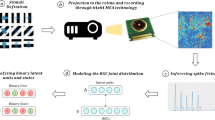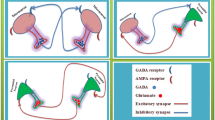Abstract
Neural circuits represent the information about external stimuli by spiking patterns. In the past 20 years, the development of multi-electrode synchronous recording technology has allowed scientists to obtain the recordings from cells in a complete neural circuit. These recordings have shown a significant correlation between cells. It is challenging to analyze how the brain discriminates stimuli from the correlated population activity. Here we propose a method to quantify the distance between two neural responses accurately based on the correlated structure of neural activity. We use the Deep Boltzmann Machine and convolutional Deep Boltzmann Machine to learn the synchronous activity of 60 retinal ganglion cells and define a novel neural metric from the model by the Fisher score. The metric can be directly applied to the spike trains to distinguish the input stimuli. We show that compared with the existing metrics, our proposed metric performs better in unsupervised spike clustering tasks on both simulated data and real data. Our work provides an accurate calculation method for brain-computer interfaces to discriminate the stimuli based on the spiking responses they elicit.









Similar content being viewed by others
References
Ye R, Liu X (2020) How the known reference weakens the visual oblique effect: a Bayesian account of cognitive improvement by cue influence. Sci Rep 10:20269
Chen Z, Liu X (2019) Bayesian inference for variability discrimination on partial sameness. Neurocomput Neural Comput 359:163–172
Victor JD (2015) Spike train distance. Encycl Comput Neurosci 2808–2814
Satuvuori E, Kreuz T (2018) Which spike train distance is most suitable for distinguishing rate and temporal coding? J Neurosci Methods 299:22–33
Yi Z, Xu T, Guo S, Shang W, Wu X (2020) Tactile surface roughness categorization with multineuron spike train distance. IEEE Trans Autom Sci Eng
van Rossum MC (2001) A novel spike distance. Neural Comput 13(4):751–763
Mulansky M, Bozanic N, Sburlea A, Kreuz T (2015) A guide to time-resolved and parameter-free measures of spike train synchrony. In: International conference on event-based control, communication, and signal processing, pp 1–8
Bhattacharjee AS, Konakamchi S, Turaev D et al (2019) Similarity and strength of glomerular odor representations define a neural metric of sniff-invariant discrimination time. Cell Rep 28(11):2966–2978
Dupre C, Yuste R (2017) Non-overlapping neural networks in hydra vulgaris. Curr Biol 27(8):1085–1097
Dana H, Sun Y, Mohar B et al (2019) High-performance calcium sensors for imaging activity in neuronal populations and microcompartments. Nat Methods 16(7):649–657
Valle C, Rodriguez-Fernandez M, Eblen-Zajjur A (2020) Spikes and nets (S&N): a new fast, parallel computing, point process software for multineuronal discharge and connectivity analysis. Neural Process Lett 52:385–402
Cámera A, Belluscio MA, Tomsic D (2020) Multielectrode recordings from identified neurons involved in visually elicited escape behavior. Front Behav Neurosci 14
Abbott J, Ye T, Krenek K, Gertner RS, Ham D (2020) A nanoelectrode array for obtaining intracellular recordings from thousands of connected neurons. Nat Biomed Eng 4(2):1–10
Ferrari U (2016) Learning maximum entropy models from finite-size data sets: A fast data-driven algorithm allows sampling from the posterior distribution. Phys Rev E 94(2):023301
Hernández-Navarro L, Orlandi JG, Cerruti B et al (2017) Dominance of metric correlations in two-dimensional neuronal cultures described through a random field Ising model. Phys Rev Lett 118(20):208101
Nghiem TA, Marre O, Destexhe A, Ferrari U (2017) Pairwise Ising model analysis of human cortical neuron recordings. In: International conference on geometric science of information, pp 257–264
Zanoci C, Dehghani N, Tegmark M (2019) Ensemble inhibition and excitation in the human cortex: an Ising-model analysis with uncertainties. Phys Rev E 99(3):032408
Nghiem TA, Teleńczuk B, Marre O, Destexhe A, Ferrari U (2018) Maximum entropy models reveal the correlation structure in cortical neural activity during wakefulness and sleep. bioRxiv 243857. https://doi.org/10.1101/243857
O’Donnell C, Goncalves JT, Whiteley N, Portera-Cailliau C, Sejnowski TJ (2017) The population tracking model: a simple, scalable statistical model for neural population data. Neural Comput 29(1):50–93
Gardella C, Marre O, Mora T (2018) Blindfold learning of an accurate neural metric. Proc Natl Acad Sci 115(13):3267–3272
Volpi R, Zanotto M, Maccione A et al (2020) Modeling a population of retinal ganglion cells with restricted Boltzmann machines. Sci Rep 10(1):1–10
van der Plas T L, Tubiana J, Le Goc G, et al (2021) Compositional restricted Boltzmann machines unveil the brain-wide organization of neural assemblies. bioRxiv
Salakhutdinov RR, Hinton GE (2009) Deep Boltzmann machines. J Mach Learn Res 5(2):1967–2006
Roudi Y, Taylor G (2015) Learning with hidden variables. Curr Opin Neurobiol 35:110–118
Zhang N, Ding S, Zhang J, Xue Y (2018) An overview on restricted Boltzmann machines. Neural Comput 275:1186–1199
Carreira-Perpinan MA, Hinton GE (2005) On contrastive divergence learning. Artif Intell Stat 10:33–40
Karakida R, Okada M, Amari SI (2016) Dynamical analysis of contrastive divergence learning: restricted Boltzmann machines with Gaussian visible units. Neural Netw 79:78–87
Wang J, Wang K, Wang Y, Huang Z, Xue R (2019) Deep Boltzmann machine based condition prediction for smart manufacturing. J Ambient Intell Humaniz Comput 10(3):851–861
Duong CN, Luu K, Quach KG, Bui TD (2019) Deep appearance models: a deep boltzmann machine approach for face modeling. Int J Comput Vis 127(5):437–455
Salakhutdinov RR, Hinton GE (2012) An efficient learning procedure for deep boltzmann machines. Neural Comput 24(8):1967
Sun L, Zhang XY, Qian YH, Xu JC, Zhang SG, Tian Y (2019) Joint neighborhood entropy-based gene selection method with fisher score for tumor classification. Appl Intell 49(4):1245–1259
Uchida Y, Sakazawa S, Satoh SI (2016) Image retrieval with fisher vectors of binary features. In: 2nd IAPR Asian conference on pattern recognition (ACPR), pp 23–28
Du T, Liao L, Wu CH, Sun B (2016) Prediction of residue-residue contact matrix for protein-protein interaction with Fisher score features and deep learning. Methods 110:97–105
Ahmed S, Azim T (2020) Diversified Fisher kernel: encoding discrimination in Fisher features to compete deep neural models for visual classification task. IET Comput Vis 14(8):658–664
Ferrari U, Gardella C, Marre O, Mora, T (2017) Closed-loop estimation of retinal network sensitivity reveals signature of efficient coding. eNeuro 4:e0166–17
Schaub MT, Schultz SR (2012) The Ising decoder: reading out the activity of large neural ensembles. J Comput Neurosci 32(1):101–118
Acknowledgements
The authors are grateful to the anonymous reviewers and the Editors for their valuable comments and constructive suggestions that greatly improved the paper. This work is supported by National NSF (61374183, 51535005) of China, National Key Research and Development Program of China (2019YFA0705400), the Research Fund of State Key Laboratory of Mechanics and Control of Mechanical Structures (MCMS-I-0421K01), and a project funded by Priority Academic Program Development of Jiangsu Higher Education Institutions.
Author information
Authors and Affiliations
Corresponding author
Additional information
Publisher's Note
Springer Nature remains neutral with regard to jurisdictional claims in published maps and institutional affiliations.
Rights and permissions
About this article
Cite this article
Yang, C., Liu, X. A Novel Neural Metric Based on Deep Boltzmann Machine. Neural Process Lett 54, 4325–4340 (2022). https://doi.org/10.1007/s11063-022-10810-z
Accepted:
Published:
Issue Date:
DOI: https://doi.org/10.1007/s11063-022-10810-z




